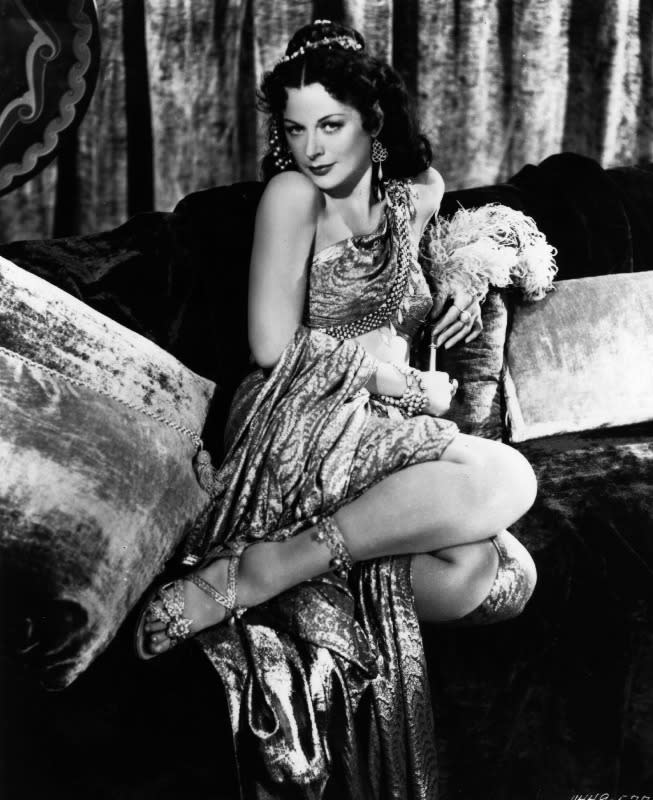Celebrating Hedy Lamarr: Military Technology Inventor and First Woman To Fake It In Film [Video]
If you’ve been Googling today (of course you have), you may have seen that the Google Doodle dujour is an animated tribute to Austrian American actress and inventor Hedy Lamarr. A prolific film star, Lamarr is also known as the first movie star to simulate on orgasm onscreen. Surprisingly, she was also a frequency-hopping inventor whose technology is now the basis for Bluetooth and Wi-Fi technologies. Today would have been her 101st birthday, and the actress, who was widely known as the “most beautiful woman in the world” during her career from the 1930s to the 1950s, has made her mark on history in variety of monumental ways. Anne Hathaway even said her performance in the 2004 film Catwoman was based on Lamarr’s persona. Here are three reasons to celebrate Hedy Lamarr, a true Renaissance woman of the twentieth century:

Today would have been Hedy Lamarr’s 101st birthday. (Photo: Getty Images)
She was the first movie star to simulate an orgasm onscreen.
At only 18 years old, she filmed a simulated orgasm scene in Gustav Machatý’s 1933 Czech film, Ecstasy, which is actually not a pornographic film. She portrayed a neglected wife married to an older man, and orgasm scene aside, the film also included Lamarr swimming and running through the woods in the nude. Her first husband (out of six husbands in her lifetime), objected to the “the expression on her face” in the film and attempted to buy as many copies as possible to restrict its viewing. In her autobiography, Lamarr insisted that the orgasm was simulated using method-acting reality — the director pricked her repeatedly with a safety pin off-screen. Lamarr, who was born Jewish, later realized that her first husband was controlling and hosting parties for Hitler and Mussolini (which Lamarr had to be present for). So she disguised herself as her own maid and fled the country.

Movie star Hedy Lamarr appeared in a variety of Old Hollywood films. (Photo: Getty Images)
She was a prolific inventor who wanted to use science to defeat the Axis powers.
Lamarr’s first husband was the third richest man in Austria and a military arms merchant. She oftentimes accompanied him to business meetings where she was introduced to scientists. During the Second World War, Lamarr became inspired to help out with the war effort, and she wanted to do more than use her celebrity status to sell war bonds. Lamarr, who did not attend university, invented a variety of items in her lifetime, with varying success. Some of her earliest inventions include an improved traffic spotlight and a carbonated beverage tablet. But in 1942, while she was living in California and was already a celebrated movie star, she and composer George Antheil patented a frequency-hopping system that predated Wi-Fi and Bluetooth technologies. Author Richard Rhodes told CBS that she had a room in her house just for frequency-hopping designs. Lamarr knew about torpedoes due to her first husband’s work with the military, and wanted to find a way to jam these radio-controlled torpedoes and cause them to go off-course. In August 11, 1942, U.S. Patent 2,292,387 was granted to the enterprising duo. In 1962, the technology was used by the U.S. Military during a blockade of Cuba. In 2014, she was inducted in the National Inventors Hall of Fame.

Hedy Lamarr in the 1958 film, ‘The Female Animal’. (Photo: Getty Images)
Her films defined Old Hollywood.
After signing a contract with MGM, Lamarr starred in her first Hollywood film, Algiers, opposite Charles Boyer, in 1938. The film inspired the 1942 classic film Casablanca, which was written by Warner Brothers with Lamarr in mind as the lead actress. Unfortunately, MGM refused to release Lamarr from her contract. Her in 1949 romantic religious epic film (a long-forgotten genre these days), Samson and Delilah, was the highest-grossing film of the year and was nominated for five Academy Awards. Between 1940 and 1949 while she was signed with MGM, she made 18 films and had two children. Unfortunately, it was consistently known that her roles — including the leading ones — were light on lines compared to her male counterparts’, so she turned to inventing for fulfillment.
Related:
Rad American Women A-Z: The New Alphabet You’ll Want to Learn
8 Ways Gloria Steinem Improved Our Lives
Justice Ruth Bader Ginsburg Chooses Working Out Over Dinner with the President

